Following on from Kamen Rider Amazon, Shoraro Ishinomori and Toei producer Tohru Hirayama were unsure where to go next with the Kamen Rider franchise. While initially he presented the idea of a "Five Riders" series, production studio Mainichi Broadcasting were firm in the stance that "there should be only one hero" (this concept instead became the foundation of Himitsu Sentai Gorenger, and in turn the Super Sentai franchise). So instead they looked toward a more back to basics approach, and in April 1975 Kamen Rider Stronger burst onto Japanese television screens. However while the origins of Stronger were certainly more in line with the traditional Kamen Rider template, there was one fundamental difference – the addition of female sidekick, conceived after Hirayama and Ishinomori received fan letters from young girls who wanted a hero they could pretend to be when playing Kamen Rider with other boys. Though originally proposed to run for a full 52 episodes, low audience ratings resulted in it being cut short at 39 and at the time Stronger was considered to be the end of the Kamen Rider series.
Following the death of his close friend and mentor, Shigeru Jo joins the evil Black Satan organisation. Promised great power in return, Shigeru agrees to undergo surgery to become one of Black Satan's cyborg soldiers. However secretly Shigeru knows Black Satan were responsible for his friend's death, and is simply using the organisation to gain the power he needs to bring them down. Escaping their headquarters before the brainwashing is complete, he becomes Kamen Rider Stronger.
Teaming up with Yuriko Misaki, another cyborg with the ability to become the Electro-Wave Human Tackle, the pair combat Black Satan and their Kikkaijin to restore peace to Japan. However they aren't the only evil force they have to battle against, and in the ashes of Black Satan the Delzer Army rises to take their place.
Teaming up with Yuriko Misaki, another cyborg with the ability to become the Electro-Wave Human Tackle, the pair combat Black Satan and their Kikkaijin to restore peace to Japan. However they aren't the only evil force they have to battle against, and in the ashes of Black Satan the Delzer Army rises to take their place.
Though wilder concepts for the series had been cast aside, right from the very beginning Kamen Rider Stronger opens with a very different feel to previous series. Rather than begin with the hero’s origin story, Stronger immediately kicks that tradition to the curb - saving that tale for episode two and instead dropping the audience in with an already established Stronger and Tackle. While not an uncommon tactic in television, it was a new move for Rider at the time and a very effective one at that. But as much promise as Stronger shows from the word go, the series isn’t without its production shortcomings. In fact Stronger is particularly notorious for its shoestring budget - an aspect that can be particularly seen in many of the monster costumes. The everlasting charm of tokusatsu though is that budgetary issues often only serve to push the limits of the medium further, and despite these obstacles Stronger makes good use of what it does have to be a great show in its own right.
Heading up Stronger’s spectacular cast is Shigeru, played by the late Shigeru Araki. Though his origins as a cyborg vowing to fight back against his creators draws immediate comparisons to many of his predecessors, Shigeru comes across as much less of a ‘tortured hero’. In fact he’s a far more rough around the edges character - brash and often lacking in patience and tact. He puts up a front of being a fearless hero, but behind that is that same Kamen Rider desire to fight back against evil. Through the time he spends with both Yuriko and Tobei Tachibana (who returns one final time to help mentor the titular, having appeared in every series since the original) and the battles they face Shigeru eventually softens over time - effectively completing his journey from a hot-headed youth who risked his life becoming a cyborg for the sake of revenge. While the cockier edge he exhibits in those earlier episodes makes for a nice change of pace, it’s that evolution that makes the character truly satisfying.
While his character origins retain that familiar Kamen Rider feel, visually there's a definite shift toward the pomp of not only the superhero boom Japan was in the midst, but also perhaps American heroes as well. This can particularly be seen in Stronger's suit design, particularly in its more muscular design and bright colour scheme. It was a unique design amongst the Showa-era Riders and arguably continues to be today, particularly with the use of multi-holed eye pieces (much like those used on the Gorenger suits) as opposed to the traditional compound eyes. Even the S emblem on his chest, though his own initial, has strong Superman connotations. The man even has an (albeit lengthy) catchphrase, again something that’s a lot more common now but at the time far less heard of within the franchise. The later appearance of Stronger's more powerful 'Charge Up' form feels almost prophetic of how the franchise would later develop, albeit handled in a very different way.
The inclusion of Tackle proves to be one of Stronger's more interesting assets, particularly in the uneven way the show ends up treating her. There's no understating how important Tackle's place in the Kamen Rider franchise is – even if Toei unfairly deny her the title of Kamen Rider she is the template of everything that has come since, and her legacy deserves to be remembered as such. But as the very first Kamen Rider heroine, debuting at a time when sensibilities toward what's still to this day largely considered as a "boys' franchise" were very different naturally her depiction in the series isn't always the best. On the more positive side of things, Yuriko is another incredible character that the show wields – strong-willed and often more level-headed than Shigeru himself. But on the other hand, while Tackle is repeatedly shown to be a competent fighter Stronger always has to be the one to save the day. Tackle is more than adept at fighting Black Satan's combatmen, but any fight against a Kikkaijin usually results in defeat and capture – leaving Stronger to be the one to save the day. Behind the scenes this was due to actress Kyoko Handa's, who played Tackle both in and out of suit, severe asthma – an affliction which she tragically passed away from at only 27. Her "Electro Wave Toss" attack was developed as a result of this, in order to minimize as much strenuous activity as possible. While does account for some of the way Tackle is depicted, nevertheless it's unfortunate that she's only really able to stand out as an equal to Stronger at the very end.
While the episodic schemes of Black Satan and their Kikkaijin are enjoyable enough, often they don't prove to be especially memorable in the grand scheme of Showa-era tokusatsu stock plots. However Kamen Rider Stronger really makes up for this through the development its recurring characters. Rivalry is a theme that plays heavily throughout the series between both the heroes and villains – even Shigeru and Yuriko come across as having a sort of friendly rivalry at times. But its Stronger's villains that really hammer this point home, not only forming intense rivalries with Stronger himself but also each other. It all begins with the introduction of Black Satan's first general – the smooth-talking, cigarette smoking Mister Titan. Developing an intense rivalry with Stronger, Titan's obsession with destroying his enemy not only sees him sacrificing his own men to further his goals but also modifying his own body to outdo him. His design also shows how less is often more - often retaining his sharp dress sense even in monster form, the only difference being his black head devoid any features other than on gigantic eye (powered-up versions would add more eyes, but the original still remains the best). Much in the way Titan sees them as expendable, the monsters of the week always feel like they're playing second fiddle to the scenes where he is interacting with Stronger.
Titan's first defeat gives way to the introduction of General Shadow, the second of Black Satan's officers and possibly the show's best character. Whereas Titan would do whatever it takes to beat Stronger, Shadow comes at their rivalry from more of a point of respect – acknowledging his power and vowing that he will be the one to defeat him once and for all. In a few short episodes Shadow is able to build up his own dynamic with Shigeru, but it's made all the more interesting when Titan is resurrected. From there on it becomes a case of Black Satan's Great Leader continuously playing his generals off against each other, with each of them willing to sabotage the other in order to have the glory and satisfaction of being the one to defeat Stronger. This is the area where General Shadow really shines – having no real loyalty to Black Satan and viewing his rivalry with Stronger on a more personal level. Shadow attempts to manipulate everyone and everything around him, and through his intense belief in divination willing helps Stronger and his allies if his deck of cards deeming it so. Like Titan, General Shadow has a somewhat simple yet incredibly striking design – that scarred veiny face peering out from behind a clear plastic helmet. This is all of course reinforced by Hidekatsu Shibata's unforgettable voice performance, and together with Akira Hamada's Titan the pair become the star attraction until Titan's eventual defeat. But as the story for General Shadow continues, it isn't hard to see why he deserves to be considered one of the greatest villains in all of Kamen Rider.
Titan's first defeat gives way to the introduction of General Shadow, the second of Black Satan's officers and possibly the show's best character. Whereas Titan would do whatever it takes to beat Stronger, Shadow comes at their rivalry from more of a point of respect – acknowledging his power and vowing that he will be the one to defeat him once and for all. In a few short episodes Shadow is able to build up his own dynamic with Shigeru, but it's made all the more interesting when Titan is resurrected. From there on it becomes a case of Black Satan's Great Leader continuously playing his generals off against each other, with each of them willing to sabotage the other in order to have the glory and satisfaction of being the one to defeat Stronger. This is the area where General Shadow really shines – having no real loyalty to Black Satan and viewing his rivalry with Stronger on a more personal level. Shadow attempts to manipulate everyone and everything around him, and through his intense belief in divination willing helps Stronger and his allies if his deck of cards deeming it so. Like Titan, General Shadow has a somewhat simple yet incredibly striking design – that scarred veiny face peering out from behind a clear plastic helmet. This is all of course reinforced by Hidekatsu Shibata's unforgettable voice performance, and together with Akira Hamada's Titan the pair become the star attraction until Titan's eventual defeat. But as the story for General Shadow continues, it isn't hard to see why he deserves to be considered one of the greatest villains in all of Kamen Rider.
Despite its episode count being cut down significantly Stronger was clearly determined to go out with a bang, with introduction of the Delzer Army in episode 27 really moving the show into high gear. As the most engaging of the villains it's excellent to see General Shadow remain so that his rivalry with Shigeru can continue. But on top of that, it also adds the rivalry between each member of the Delzer Army – creating a dynamic that's far more engaging than the formulaic plots of Black Satan. Rather than feature weekly monsters in the traditional sense, each member of Delzer Army is in fact a general – with many of them not particularly keen on the idea of being led by the already established Shadow. This in-fighting creates a great deal of storytelling for the remaining episodes, with Shadow desperately trying to cling onto power as his subordinates refute him. The Delzer Army arc also utilises far more serialised storytelling than previous episodes, again resulting in far more engaging content as the events of each episode naturally flow into one another.
The arc also culminates in the return of all six previous Riders, slowly reintroducing them over the course of several episodes before finally uniting the seven original Kamen Riders for the finale. Though admittedly they may not have been away from television screens at the time, there's just something undeniably epic about seeing them all return (both in and out of suit no less), uniting to battle against a final enemy. The original seven are also all united through their friendship with Tachibana, who is naturally elated to see his former comrades return from around the world. Though the series still very much remains Stronger's show, it feels as though equal weight is placed on each of them in the finale – in some ways bringing it back to that team show that Hirayama had originally pitched. With it being considered at the time to be the end of the Kamen Rider series, it feels as though there's a culmination of all their stories in that final episode – not necessarily handled in a way that entirely works, but an attempt was made nonetheless.
The arc also culminates in the return of all six previous Riders, slowly reintroducing them over the course of several episodes before finally uniting the seven original Kamen Riders for the finale. Though admittedly they may not have been away from television screens at the time, there's just something undeniably epic about seeing them all return (both in and out of suit no less), uniting to battle against a final enemy. The original seven are also all united through their friendship with Tachibana, who is naturally elated to see his former comrades return from around the world. Though the series still very much remains Stronger's show, it feels as though equal weight is placed on each of them in the finale – in some ways bringing it back to that team show that Hirayama had originally pitched. With it being considered at the time to be the end of the Kamen Rider series, it feels as though there's a culmination of all their stories in that final episode – not necessarily handled in a way that entirely works, but an attempt was made nonetheless.
Kamen Rider Stronger is a production that was not without its issues and in turn a series not without its flaws, but through the strength of its cast alone Toei were able to produce a show that could often rival with the best of them. Even if some of the plots or visuals don’t always quite live up to expectations, the likes of Shigeru, Yuriko, Titan and General Shadow are the kind of characters that aren’t bested easily. If Kamen Rider Stronger had truly turned out to be the end of the franchise, then honestly it would not have been a bad note to go out on. But as we all know Kamen Rider continued to live on, and the spirit of this landmark series can continue to be seen to this day.


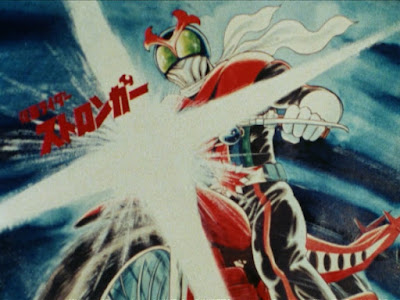
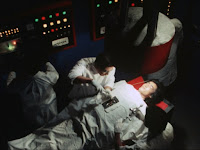
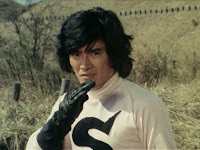


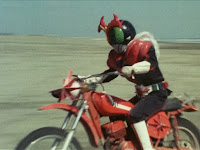
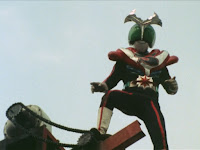




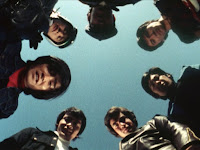


5 comments:
I always thought General Shadow's later appearances in modern rider were whatever, but his original run in Stronger was the coolest.
What good timing for this review since the last Girls Remix is coming around and Tackle (sorta) and Titan (sorta) are in it
Yeah I definitely want to go back and rewatch OOO/Den-O Let's Go at some point specifically for his scenes. I remember him being fairly cool but it's him being defeated by the Ishinomori heroes that sticks out to me more in the film.
Agree on the timing! Luckily I'd already started the series but as soon as I saw the trailer with Ms Titan I knew I had to try and get it around around the time of Girls Remix.
Always great when other Showa era seasons get some attention. It's always "Black this" and "Black that".
When you are going to review the Skyrider & Super-1 series?
Once I finish the original series :)
Post a Comment